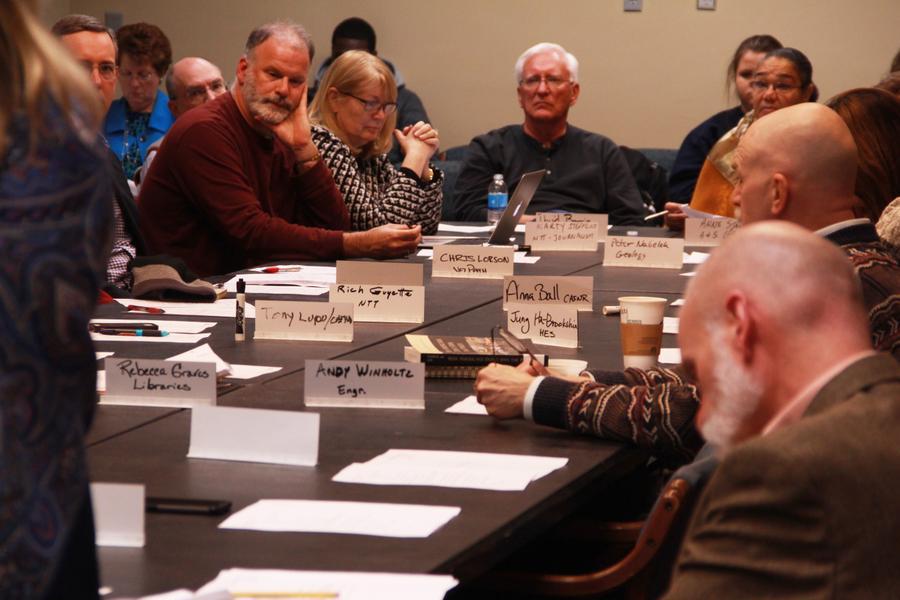
Faculty Council is considering a [proposal](http://facultycouncil.missouri.edu/meetings/attachments/2015-16/2016-01-21/fc-mu-um-resolution.pdf) that would commission an independent examination of the relationship between the UM System and MU. Depending on the examination’s conclusion, recommendations could be made to the UM System Board of Curators to consolidate the offices of the UM System president and MU chancellor, add more schools to the UM System or disband the UM System entirely.
The proposal was presented at the [Faculty Council meeting on Jan. 21](https://www.themaneater.com/stories/2016/1/21/faculty-council-proposes-examining-mu-and-um-syste/) by two members of the council’s executive committee, professors Art Jago and John Gahl. During the presentation, Jago called the unprecedented occurrence of the simultaneous vacancy of the presidency and chancellorship a “unique opportunity in the 53-year history of the UM System campus.”
Because of the vacancies, Jago said in an interview later, “if ever there’s a time to examine the system and the relationship to the campus, it’s now.”
Jago said it would be a unique chance to conduct an objective examination by an outside consultant without any loyalties to any institution or person.
“There’s no suggestion that things should necessarily change, but neither is the suggestion that change shouldn’t occur,” Jago said. “Simply because something existed for 53 years doesn’t mean it should continue to exist. Now’s the perfect time for the questions to be raised, and that’s what this proposal does—it raises questions.”
The point of the proposed examination is to determine “value added,” according to the proposal. It references the annual UM Efficiencies and Effectiveness report published in December 2015. According to the proposal, “interim (UM System) President Middleton reported $77 million in savings were generated by the System over the last two years.”
“These savings, however, are not independently audited and are based on theoretical projections, hypothetical assumptions and educated guesses of what might occur,” the proposal read.
Jago said that despite the report’s claim that the UM System saves the four campuses money, some have questioned the validity of the statement.
“A number of faculty over the years have asked what added value does the system provide,” Jago said. “And there are some obvious answers. Payroll, procurement, and a number of system functions they do and they do very well. But I’ve also heard a number of complaints over the years that the system seems to be pretty expensive. And there have been times when, as described in the proposal, some people have suggested that some system and campus functions be combined, like the president and chancellorship, which exists at some other universities as well.”
When the UM System was formed in 1963, Jago said, there were good reasons for the creation. Missouri University of Science and Technology, known as Missouri School of Mines and Metallurgy before the university system formation, had already been a branch campus of MU since its founding in 1871. UM-St. Louis was a community college and UM-Kansas City was a private school, both of which, Jago said, were being neglected.
“The reasons for the system were very good,” Jago said. “I’m just asking the question, ‘Do those reasons still exist?’ Those are mature institutions now with different goals, different responsibilities and they serve different populations and they do it very well.”
According to the proposal, the four campuses have now reached the point where similarities are hard to find.
“The campuses do not share a common fee structure, a common grading scale, nor a common course numbering system,” the proposal read.
If the examination finds that the added value of the UM System is minimal, then appropriate steps should be taken, Jago said, whether it be disbanding the four-campus system or consolidating the offices of the UM president and MU chancellor. The proposal cited other flagship universities that are not part of a system, such as the University of Iowa and University of Kansas. Other schools have a university system in which the president is also the chancellor of the flagship school, like the University of Michigan and Purdue University.
On the other hand, the proposal cites another opportunity if appropriate added value is identified: adding the other public schools in Missouri to the university system, creating a statewide system.
“I don’t think anything should be off the table,” Jago said. “If the system is good for UMSL, Rolla, UMKC and MU, why isn’t it also good for Missouri State, Truman and some of the other nine four-year universities we have in Missouri?”
Jago said he believes some would welcome the being part of the UM System, while others might think they would come up with the short end. If this was found to be a feasible option, it would be up to the legislature to decide if they wanted to expand the UM System.
During the Faculty Council presentation, some council members voiced concern over the proposal not being discussed with the other three campuses before being voted upon.
Jago, however, explained that there wouldn’t be any point in bringing the other campuses into the discussion before it was voted upon by MU’s Faculty Council.
“If we think the status quo is fine, there isn’t much of a reason for us to raise the question to the other campuses,” Jago said.
He also said that the proposal is a draft and is subject to change if the council decides it should be amended.
The proposal will be voted on at the council’s next meeting on Feb. 11. If it passes, it will then go to the curators to vote on and to the Intercampus Faculty Council to discuss among the four campuses. If the examination is conducted, the conclusions and recommendations will go to the curators and stakeholders to consider and act upon as they see necessary.
“My only position is that it’s time for an examination,” Jago said. “There is no better time than right now.”
_Edited by Taylor Blatchford | [email protected]_